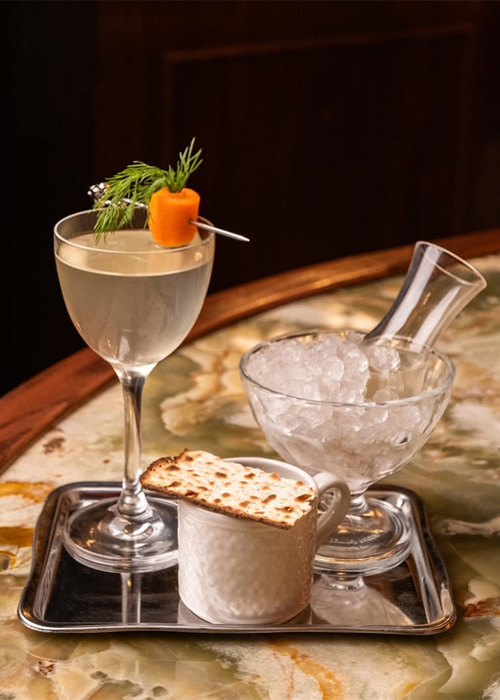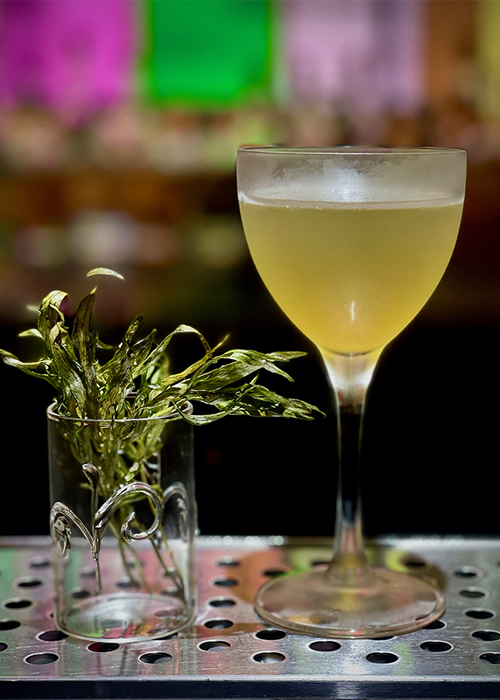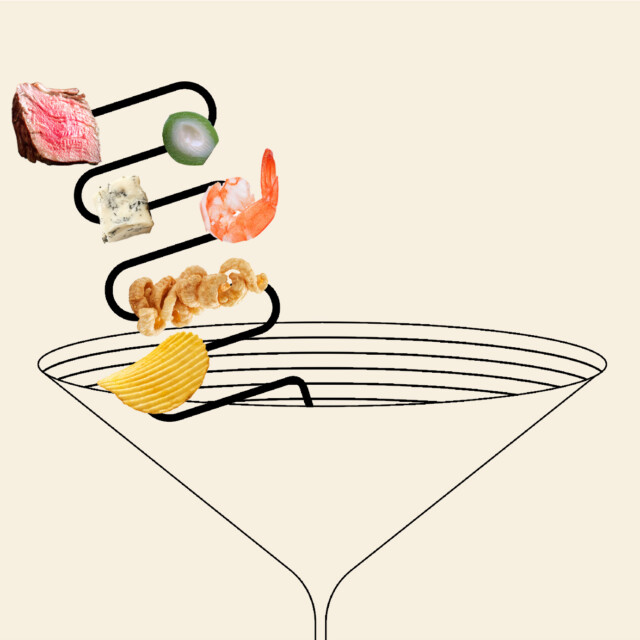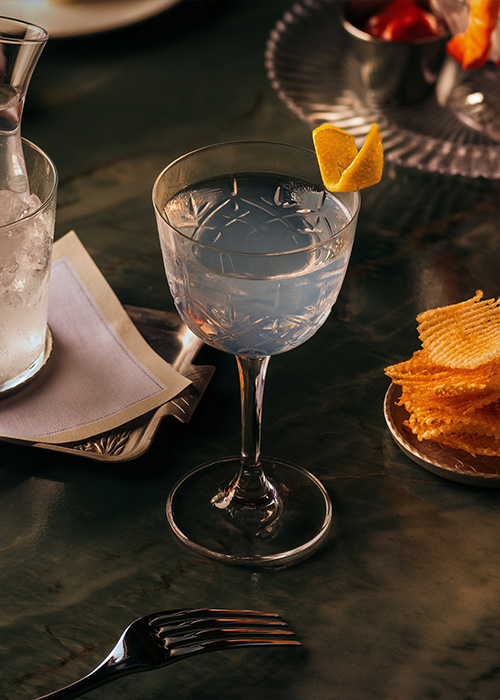In early June, cocktail influencer Hannah Chamberlain (@spiritedla) posted a video showing her version of a Filet Mignon Martini. In it, she fat-washed gin with steak drippings, froze then strained the mixture, stirred with vermouth, then garnished with blue cheese-stuffed olives and a cube of filet mignon.
The initial post was a sensation — “omg wow you POPPED OFF ON THIS ONE” wrote one commenter — with nearly 100,000 likes, quickly spawning a series Chamberlain dubbed “Weirdly Dirty Martinis.” Over the next few months she posted a Shrimp Cocktail Martini (garnished with shrimp), a Prosciutto & Melon Martini (prosciutto-wrapped melon), a Buffalo Wing Martini (blue cheese cube), a Caesar Salad Martini (crouton), and a French Onion Soup Martini (flamed gruyère).
Though these cocktails were mostly tongue in cheek for viral “content” purposes, there’s no denying that many looked quite good. Even Chamberlain and her husband admitted to enjoying a few in their tasting post-mortems.
Whether earnestly made, or aimed as a troll, what is undeniable is that the professional bar scene is likewise in pursuit of ever more garish, avant garde Martini garnishes.
The Snack-able Martini
When Iain Griffiths opened their latest bar, Bar Snack, in late November of last year, guests were greeted with a house Martini, called the Boat Snack Martini, that was as savory as any of Chamberlain’s more baroque Instagram cocktails.
“It started from my belief that every cocktail should have a snack. With so much flexibility now to make Martinis with different flavors and ingredients, the garnish adds another detail and layer of flavor for creativity and distinction.”
Culch Vodka is mixed with a vermouth blend, a chicken bouillon blend, caperberry brine, and orange bitters. Strained into a chilled Nick & Nora glass, it is garnished with an expected expressed lemon twist (discarded), but then, resting across the top of the glass, lies a crispy chicharron of chicken skin.
“I think Martinis have long been one of the most riffed and played up classics out there but as we steer away from messing so much with core product and stay a little more ‘classic’ in the drink itself, the garnish is obvious next step to still drive some creativity and help complete whatever story you’re trying to tell with your drink,” says Griffiths.
Another new Manhattan establishment, The Corner Store, which opened in September of last year, offers a lengthy Martini menu — though one stands out like no other, mainly thanks to its garnish. For the Sour Cream & Onion Martini, beverage director Lucas Robinson combines sour-cream-fat-washed gin, vermouth, spring onion, and dill. The drink arrives garnished with a side of sour cream and onion potato chips, playing on the cocktail’s salinity.

“Classic garnishes still have their place in many cocktails — especially classic Martinis. However, the world of cocktails is expanding, and with that comes the need to stray from the norm,” Robinson says. “We are now living in a world where our guests appreciate drinks that push the envelope — especially on the savory side.”
(One of those appreciators was, in fact, Taylor Swift, who has already visited twice with her coterie.)
Indeed, it’s likewise common for these more out-there garnishes to not rest on the glass, but rather arrive on the side as an accoutrement.
At Brooklyn’s Bitter Monk head bartender Ryan Garrison garnishes his Fauna & Flora Martini with a side glass of air-fried tarragon leaves. Guests are encouraged to nibble on the leaves in between sips, which creates a lingering spiciness on the palate. Garrison believes the edible garnish will bring out the herbaceous flavor notes in the Atheras Spirits Cybele, a house-made herbal liqueur contained in the drink.

“It started from my belief that every cocktail should have a snack,” Garrison says. “With so much flexibility now to make Martinis with different flavors and ingredients, the garnish adds another detail and layer of flavor for creativity and distinction.”
David Muhs, co-owner and head bartender at Monkey Thief in midtown Manhattan, agrees.
“I’ve always been a fan of functional garnishes — especially those you can eat,” he says. His The Holy Trini-Tini is a Gibson variant inspired by the holy trinity of Chinese cooking: ginger, scallion, and garlic. Gin is fat-washed with roasted garlic and scallion oil, while the vermouth is rapidly infused with fresh ginger in an iSi canister. A pickled scallion bulb and ginger ribbon serve as garnish.
“[They] not only cleanse the palate but also enhance all the delicate flavors in the glass,” Muhs says. “It’s a small but integral part of the experience that ties everything together.”
The Bloody Garnishes
Of course, not all New York bartenders are in on this madness.
“The essence of the garnish is to serve as a complement to enhance the sensorial experience of any cocktail,” says David Orellana, beverage director at New York’s Grand Brasserie, who believes the recent Netflix reality show “Drink Masters” has inspired these garnishes to run amok — not a good thing in his book. “At Grand Brasserie we are bound to tradition when it comes to Martini garnishes,” he says.
Indeed, the original Martini garnish, starting at the end of the 19th century, was a lemon twist (and, sometimes, gasp, “a cherry if desired,” according to George J. Kappeler’s 1895 work “Modern American Drinks”). The aromatics not only paired well with the botanicals of gin, it also added a bit of a lift to the drink.
By 1901 it is thought that New York bartender John O’Conner had added an olive (and its brine) as the garnish. It wouldn’t come into popularity, however, until post-Prohibition, used as a way to help ease the boozy burden of a drink that had become increasingly dry. It also served as a salty little snack.
Speaking of snacks, it’s hard not to liken this recent Martini garnish trend to a similar phenomenon from the early 2010s, which saw Bloody Mary’s lose their damn minds and begin to be garnished with everything from burger sliders to bacon-wrapped jalapeño cheese balls, poached shrimp to sausages.
By 2014, a Milwaukee pub was even offering The Bloody Beast, a Bloody Mary garnished with an entire three-and-a-half-pound, beer-battered fried chicken. The cost? $60. The bar, nevertheless, sold a couple dozen of them every single weekend.
“When you take a bite of a chip it’s like having just tasted a sip of a fully loaded baked potato. I’ve even seen people dip the chips into their Martini.”
And perhaps a similar, economic motive is behind these newfound Martini garnishes. In these days of the $20 (and growing) cost for a standard Martini, maybe guests are starting to expect a little bit more with their drinks — and an easier ability to flex them on Instagram and TikTok.
“At its core, the classic Martini is a very minimalistic cocktail,” says Chris Lemperle, beverage director at New York’s Crane Club. “With Martini-style cocktails rising in popularity, a clever choice of garnish can really make a drink stand out, both at the bar and online.”
Extra Messy
This is not only a New York sensation.
If The Corner Store has gotten tons of press for its Lay’s potato chip garnish, The Benjamin Hollywood goes one step further by using an imported French mandolin to create proprietary Kennebec Triple Fried Chips. They act as both an appetizer with dip, and serve as a garnish for the house Ben’s Martini, with 10 of the ruffled chips neatly stacked on a vintage embossed coaster next to the cocktail. Beverage director Nathan Oliver believes they pair perfectly with the botanicals in the Monkey 47 gin used in the Martini.
“When you take a bite of a chip it’s like having just tasted a sip of a fully loaded baked potato,” he says. “I’ve even seen people dip the chips into their Martini.”
If caviar pairs well with chips, it has also become a de rigeur garnish for Martinis of this era. At La Zozzona at the Grand Hyatt Scottsdale, beverage director Mark Watten allows guests to make their Martinis “extra messy” by adding a garnish of Osetra caviar. Katie Niebling, head bartender at Oregon’s Tu Tu’ Tun Lodge, likes to deploy it as well.
“My favorite Martini garnishes are caviar on a small mother-of-pearl spoon balanced on the rim of the glass for a vodka Martini,” she says. However, Niebling leans toward spicy nasturtium flowers from the garden for her gin Martinis. “People crave more fresh ingredients and raw aromas in cocktails than in the past. It used to be all about shelf stable garnishes but now a good garnish tray is the pinnacle of hyper-seasonality,” she says.
This is not necessarily just a cocktail bar phenomenon either, having spread to hotels, resorts, and, of course, restaurants. If steakhouses have long been a bastion of classic Martinis and their expected garnishes, at the new Crawford Brothers Steakhouse in Raleigh, N.C., beverage director Jordan Joseph garnishes his so-called Savory Martini with a metal skewer featuring a pepperoncini, a cornichon, and an olive. It’s such a large garnish that it gets its own sidecar bowl of ice — in many ways, as dominant a presence on the bar top as the elegant coupe glass beside it.
Maybe it’s no surprise that we would eventually start to see some of these newfangled garnishes become ersatz plays on the expected accompaniments of yore. Like at ViceVersa in Miami, where acclaimed bartender Valentino Longo offers the Avanguardia. Though built with a Sicilian Marsala wine base, Bombay Premier Cru gin, Tio Pepe Sherry, and Cocchi Dry Vermouth, it visually appears to be a fairly standard Martini. It’s even topped with a plump, oval-shaped green item — surely an olive?
But, ah… it’s actually a delicate Japanese baby peach called a Wakamomo.

